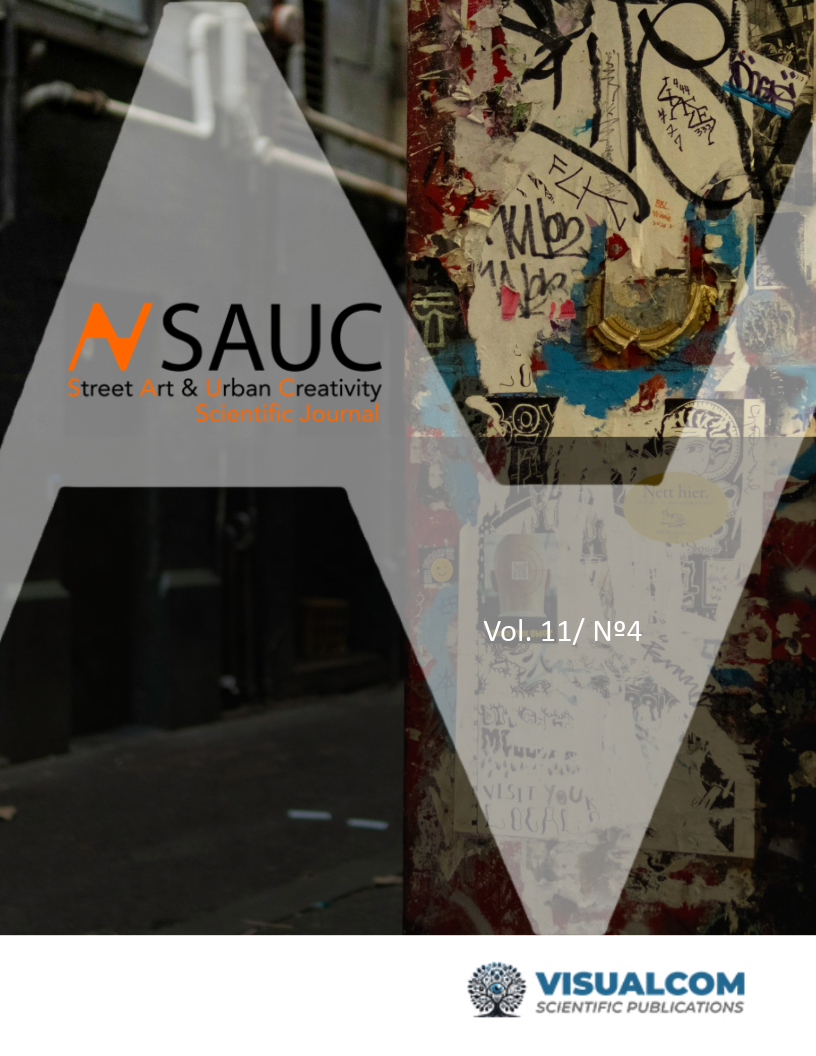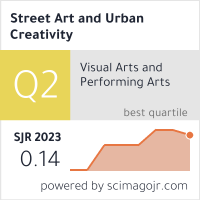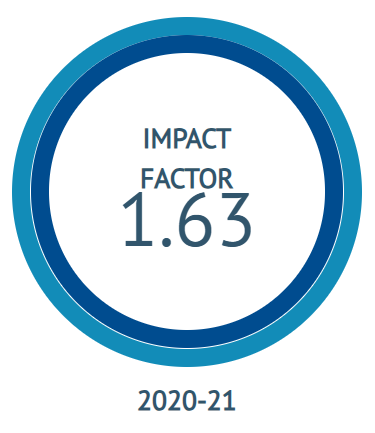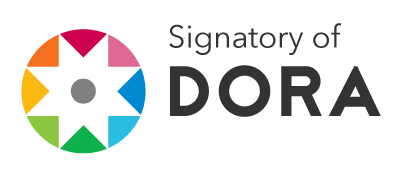Igualdad y diversidad en X durante los Juegos Olímpicos de París 2024
DOI:
https://doi.org/10.62161/sauc.v11.5815Palabras clave:
X, Redes sociales, Juegos olímpicos, Inclusión, Diversidad, Igualdad, DeportesResumen
La investigación analiza la conversación en la red social X relacionada con la igualdad y la diversidad durante la celebración de los juegos olímpicos de París en 2024. A través del análisis de redes sociales y de la estadística inferencial se descubrió la existencia de cinco grandes grupos de conversación en donde los temas relacionados con lo transgénero son los más frecuentes sin ninguna presencia de conversación entre los usuarios. Además, se descubrieron correlaciones positivas significativas entre el sentimiento positivo y la subjetividad de los posts y su engagement y la no existencia de diferencias significativas entre el formato de los mensajes (texto, imagen o vídeo) y el índice de interacción obtenido. Por último, no se detectó la presencia del efecto Boomerang en la red.
Descargas
Estadísticas globales ℹ️
|
357
Visualizaciones
|
184
Descargas
|
|
541
Total
|
|
Citas
Afolaranmi, A. O., & Amodu, A. A. (2022). Critical review of sustainable peace, mediative dialogue and social media. Critical Review, 5(3), 28-43. https://doi.org/10.52589/AJSSHR-34WCGPMN
Ahmadi, I., Waltenrath, A., & Janze, C. (2023). Congruency and users’ sharing on social media platforms: a novel approach for analyzing content. Journal of advertising, 52(3), 369-386. https://doi.org/10.1080/00913367.2022.2055683
Álvarez-Ferrándiz, D., Úbeda-Sánchez, Á. M., & García Fernández-Valdecasas, B. (2023). Propuestas para evitación de un discurso del odio en cada una de sus fases de elaboración. Investigación educativa como factor de avance en las aulas 5.0.-(Educación), 99-109. https://doi.org/10.2307/jj.5076216.13
Aral, S. (2021). The hype machine: How Social Media Disrupts Our Elections, Our Economy, and Our Health--and How We Must Adapt. Currency.
Arguelles, J. J. I., Oberto, C. L. G., Gutiérrez, T. D. J. M., & Rodríguez, R. C. (2024). Implementación de las TICS para fomentar el diálogo en la educación universitaria. Dilemas contemporáneos: Educación, Política y Valores, XII(1), 16. https://doi.org/10.46377/dilemas.v12i1.4277
Bahador, B. (2021). Countering hate speech. In The Routledge companion to media disinformation and populism (pp. 507-518). Routledge. https://doi.org/10.4324/9781003004431-53
Barnes, A. J., & Shavitt, S. (2024). Top Rated or Best Seller? Cultural Differences in Responses to Attitudinal versus Behavioral Consensus Cues. Journal of Consumer Research, 51(2), 276-297. https://doi.org/10.1093/jcr/ucad074
Ben-David, A. (2020). Counter-archiving Facebook. European Journal of Communication, 35(3), 249-264. https://doi.org/10.1177/0267323120922069
Bonilla-del-Río, M., Castillo-Abdul, B., García-Ruiz, R., & Rodríguez-Martín, A. (2022). Influencers With Intellectual Disability in Digital Society: An Opportunity to Advance in Social Inclusion. Media and Communication, 10(1). https://doi.org/10.17645/mac.v10i1.4763
Bozdağ, Ç. (2020). Managing Diverse Online Networks in the Context of Polarization: Understanding How We Grow Apart on and through Social Media. Social Media + Society, 6(3). https://doi.org/10.1177/2056305120975713
Brändle, G., Zapatero, M. D. C., & Rebollo, M. A. P. (2024). Sentir el odio: análisis de la gravedad percibida de los discursos de odio en la población española. RES. Revista Española de Sociología, 33(2), 11. https://doi.org/10.22325/fes/res.2024.219
Castellanos, M., Wettstein, A., Wachs, S., Kansok-Dusche, J., Ballaschk, C., Krause, N., & Bilz, L. (2023). Hate speech in adolescents: A binational study on prevalence and demographic differences. En Frontiers in Education (Vol. 8). Frontiers Media SA. https://doi.org/10.3389/feduc.2023.1076249
Chen, K., Jeon, J., & Zhou, Y. (2021). A critical appraisal of diversity in digital knowledge production: Segregated inclusion on YouTube. New Media & Society, 25(11). https://doi.org/10.1177/14614448211034846
Cinelli, M., Morales, G. D. F., Galeazzi, A., Quattrociocchi, W., & Starnini, M. (2021). The echo chamber effect on social media. Proceedings of the National Academy of Sciences, 118(9), e2023301118. https://doi.org/10.1073/pnas.2023301118
Clauset, A., Newman, M. E. J., & Moore, C. (2004). Finding community structure in very large networks, Physical Review Journals, 70. https://doi.org/10.1103/PhysRevE.70.066111
Delgado, R., & Stefancic, J. (2023). Critical race theory: An introduction (Vol. 87). NyU press. https://doi.org/10.5040/9780567677655.0035
Fletcher, R., Cornia, A., & Nielsen, R. K. (2019). How Polarized Are Online and Offline News Audiences? A Comparative Analysis of Twelve Countries. The International Journal Of Press/Politics, 25(2), 169-195. https://doi.org/10.1177/1940161219892768
Gámez, T. R., & Rodríguez-Casado, R. (2023). Educación social ante los discursos de odio: competencias interculturales en la formación universitaria. Journal of Supranational Policies of Education, (19), 68-83. https://doi.org/10.15366/jospoe2024.19.004
Gardner, A., Love, A., & Waller, S. (2022). How do elite sport organizations frame diversity and inclusion? A critical race analysis. Sport Management Review, 26. https://doi.org/10.1080/14413523.2022.2062975
Gómez-Marí, I., Sanz-Cervera, P., & Tárraga‐Mínguez, R. (2021). Today Is My Day: Analysis of the Awareness Campaigns’ Impact on Functional Diversity in the Press, on Google, and on Twitter. International Journal of Environmental Research and Public Health, 18(15). https://doi.org/10.3390/ijerph18157789
Gregory, A., & Halff, G. (2020). The damage done by big data-driven public relations. Public Relations Review, 46(2), 101902. https://doi.org/10.1016/j.pubrev.2020.101902
Hansen, D., Shneiderman, B., & Smith, M. A. (2010). Analyzing Social Media Networks with NodeXL: Insights from a Connected World. En Graduate Journal of Social Science. https://doi.org/10.1016/B978-0-12-382229-1.00011-4
Hietanen, M., & Eddebo, J. (2023). Towards a definition of hate speech—With a focus on online contexts. Journal of Communication Inquiry, 47(4), 440-458. https://doi.org/10.1177/01968599221124309
Ipar, E., Weglein, L., & Cuesta, M. (2024). Discursos de odio: Una alarma para la vida democrática. UNSAM edita.
Iranzo-Cabrera, M., & Calvo, D. (2023). «¿En qué datos se basa usted para afirmar eso?»: Prácticas culturales contra el discurso de odio en Twitter. En Desórdenes informativos: periodismo, política y ciudadanía ante la desinformación. Gedisa.
Kindermann, D. (2023). Against ‘hate speech’. Journal of Applied Philosophy, 40(5), 813-835. https://doi.org/10.1111/japp.12648
Kluch, Y., & Wilson, A. (2020). #NCAAInclusion: Using Social Media to Engage NCAA Student-Athletes in Strategic Efforts to Promote Diversity and Inclusion. Journal of Sport Communication, 9(1). https://doi.org/10.1123/cssm.2019-0027
Kubin, E., & von Sikorski, C. (2021). The role of (social) media in political polarization: a systematic review. Annals of the International Communication Association, 45(3), 188–206. https://doi.org/10.1080/23808985.2021.1976070
Kulenović, E. (2023). Should Democracies Ban Hate Speech? Hate Speech Laws and Counterspeech. Ethical Theory and Moral Practice, 26(4), 511-532. https://doi.org/10.1007/s10677-022-10336-2
Leal-Fernández, I., & Ruiz San Román, J. A. (2023). Videoactivismo en redes: Credibilidad, viralidad y emocionalidad. Tendencias Sociales. Revista de Sociología, (10), 99–134. https://doi.org/10.5944/ts.2023.37977
Loria, S. (2018). textblob Documentation. https://bit.ly/3GpKCY8
Ma, Y., & Hmielowski, J. D. (2021). Are You Threatening Me? Identity Threat, Resistance to Persuasion, and Boomerang Effects in Environmental Communication. Environmental Communication, 16(2), 225-242. https://doi.org/10.1080/17524032.2021.1994442
Marshall, I. C., Hammer, L. A., Springfield, C., & Bonfils, K. (2022). Activism in the Digital Age: The Link Between Social Media Engagement With Black Lives Matter-Relevant Content and Mental Health. Psychological Reports. https://doi.org/10.1177/00332941221146706
Martín-Cárdaba, M. Á., Carrasco-Polaino, R., & Cuesta-Cambra, U. (2020). Twitter Networks’ Centrality Measures of the Association of Health Journalist (ANIS): the Case of Vaccines-Introduction and Theoretical Framework. European Journal of Social Sciences, 3(2), 12-23.
Mas, J. M., Gómez, A., & Carrero, O. (2023). Emotions in fear communication: A cross‐cultural neuromarketing approach. Psychology And Marketing, 41(4), 697-718. https://doi.org/10.1002/mar.21947
Montells, L. (2016). Engagement en Twitter: qué es y para qué sirve. metricool. https://bit.ly/2JW459A
Nave, E., & Lane, L. (2023). Countering online hate speech: How does human rights due diligence impact terms of service? Computer Law & Security Review, 51. https://doi.org/10.1016/j.clsr.2023.105884
Nizamidou, C. (2022). Provocative products, the boomerang effect, the shooting star crisis and the panacea of workforce diversity. EuroMed Journal of Business, 18(2), 248-269. https://doi.org/10.1108/emjb-05-2021-0067
Ojeda Puig, C. (2021). Exclusión social, entre la aporofobia y la agnotología: tratamiento periodístico de los informes Foessa en el nuevo entorno mediático (2014-2019).
Ostertagová, E., Ostertag, O., & Kováč, J. (2014). Methodology and Application of the Kruskal-Wallis Test. Applied Mechanics and Materials, 611, 115-120. https://doi.org/10.4028/www.scientific.net/AMM.611.115
Picado, E. M., Yurrebaso, A., & Ordaz, R. G. (2023). Respuesta social ante la aporofobia: retos en la intervención social. IDP: revista de Internet, derecho y política= revista d'Internet, dret i política, (37), 3. https://doi.org/10.7238/idp.v0i37.400081
Protopapa, I., & Plangger, K. (2023). Diversity and Inclusion Practices in Marketing Education: A Conceptual Framework and Overview of the Special Issue. Marketing Education Review, 33(1), 1-6. https://doi.org/10.1080/10528008.2023.2173846
Puerta, A. J. F. (2023). Incitación al odio y colectivos vulnerables, del Derecho internacional al Derecho español: especial referencia al delito de incitación al odio por motivos religiosos. Revista de la Facultad de Derecho de México, 73(285), 361-382. https://doi.org/10.22201/fder.24488933e.2023.285.85434
Putriani, I., & Aras, M. (2022). Elevate Company's Social Media as a Diversity, Equity, and Inclusion Platform: Multi Cases Study to Digital Technology Companies. Journal of World Science, 1(10). https://doi.org/10.36418/jws.v1i10.105
Ramón Ortiz, J. Á., & Vilchez Guizado, J. (2023). Discurso de odio en educación secundaria: efectos intelectuales y emocionales. Visual Review, 14(1). https://doi.org/10.37467/revvisual.v10.4600
Ramon, X., & Rojas-Torrijos, J. (2021). Exploring Agenda Diversity in European Public Service Media Sports Desks: A Comparative Study of Underrepresented Disciplines, Sportswomen and Disabled Athletes’ Coverage on Twitter. Journalism Studies, 22(2). https://doi.org/10.1080/1461670X.2020.1809497
Restrepo B, L. F., & González L, J. (2016). De Pearson a Spearman. Revista Colombiana de Ciencias Pecuarias, 20(2), 183-192. https://doi.org/10.17533/udea.rccp.324135
Romero, M. J. G. (2024). El discurso de odio y la protección de derechos fundamentales: Un análisis de su efectividad e impacto en el ámbito laboral. Cuadernos de Res Publica en derecho y criminología, (3), 96-107. https://doi.org/10.46661/respublica.9547
Sánchez-Manzano, J. A., Sánchez-Holgado, P., & Arcila-Calderón, C. (2024). Historia y evolución de los discursos de odio a través de su propagación en los medios audiovisuales durante el siglo XX. Cuadernos del Audiovisual| CAA, (12), 49-73. https://doi.org/10.62269/cavcaa.33
Saveski, M., Beeferman, D., McClure, D., & Roy, D. (2021). Engaging Politically Diverse Audiences on Social Media. Proceedings of the 16th International Conference on Web and Social Media (ICWSM). https://doi.org/10.1609/icwsm.v16i1.19342
Schallhorn, C., Nölleke, D., Sinner, P., Seeger, C., Nieland, J.-U., & Horky, T. (2022). Mediatization in Times of Pandemic: How German Grassroots Sports Clubs Employed Digital Media to Overcome Communication Challenges During COVID-19. Communication & Sport, 10(5), 891-912. https://doi.org/10.1177/21674795221109759
Schmid, U. K., Kümpel, A. S., & Rieger, D. (2024). How social media users perceive different forms of online hate speech: A qualitative multi-method study. New media & society, 26(5). https://doi.org/10.1177/14614448221091185
Schmuck, D. (2021). Following Social Media Influencers in Early Adolescence: Fear of Missing Out, Social Well-Being and Supportive Communication with Parents. Journal Of Computer-Mediated Communication, 26(5), 245-264. https://doi.org/10.1093/jcmc/zmab008
Scott, J. (2017). Social Network Analysis. SAGE Publications. https://doi.org/10.4135/9781529716597
Segura, M. S. (2023). Discursos de odio, desinformación, negacionismos y democracia: Sección Perspectivas. Cuadernos de Coyuntura, 8, 1-6.
Siegel, A. A. (2020). Online hate speech. Social media and democracy: The state of the field, prospects for reform, 56-88. https://doi.org/10.1017/9781108890960.005
Sunstein, C. R. (2021). Liars. En Oxford University Press eBooks. https://doi.org/10.1093/oso/9780197545119.001.0001
Teklu, S. W., & Abebaw, Y. F. (2024). Analysis of the hate speech and racism co-existence dissemination model with optimal control strategies. Chaos, Solitons & Fractals: X, 12, 100109. https://doi.org/10.1016/j.csfx.2024.100109
Vraga, E. K., & Tully, M. (2019). News literacy, social media behaviors, and skepticism toward information on social media. Information, Communication & Society, 24(2), 150–166. https://doi.org/10.1080/1369118X.2019.1637445
Vredenburg, J., Kapitan, S., Spry, A., & Kemper, J. A. (2020). Brands Taking a Stand: Authentic Brand Activism or Woke Washing? Journal Of Public Policy & Marketing, 39(4), 444-460. https://doi.org/10.1177/0743915620947359
Yañez García-Bernalt, I. (2023). Reflexiones sobre los delitos de odio y las víctimas especialmente vulnerables. Revista de Estudios Jurídicos y Criminológicos, (8), 45-78. https://doi.org/10.25267/REJUCRIM.2023.i8.03
Zapatero, M. D. C., Makhortykh, M., & Segado-Boj, F. (2022). Discursos de odio en comunicación: Investigaciones y propuestas. Comunicar: Revista Científica de Comunicación y Educación, (71), 1-4.
Descargas
Publicado
Cómo citar
Número
Sección
Licencia
Derechos de autor 2025 Los autores/as conservan los derechos de autor y ceden a la revista el derecho de la primera publicación y el derecho de edición

Esta obra está bajo una licencia internacional Creative Commons Atribución-SinDerivadas 4.0.
Los autores/as que publiquen en esta revista aceptan las siguientes condiciones:
- Los autores/as conservan los derechos de autor.
- Los autores/as ceden a la revista el derecho de la primera publicación. La revista también posee los derechos de edición.
- Todos los contenidos publicados se regulan mediante una Licencia Atribución/Reconocimiento-SinDerivados 4.0 Internacional. Acceda a la versión informativa y texto legal de la licencia. En virtud de ello, se permite a terceros utilizar lo publicado siempre que mencionen la autoría del trabajo y a la primera publicación en esta revista. Si transforma el material, no podrá distribuir el trabajo modificado.
- Los autores/as pueden realizar otros acuerdos contractuales independientes y adicionales para la distribución no exclusiva de la versión del artículo publicado en esta revista (p. ej., incluirlo en un repositorio institucional o publicarlo en un libro) siempre que indiquen claramente que el trabajo se publicó por primera vez en esta revista.
- Se permite y recomienda a los autores/as a publicar su trabajo en Internet (por ejemplo en páginas institucionales o personales), una vez publicado en la revista y citando a la misma ya que puede conducir a intercambios productivos y a una mayor y más rápida difusión del trabajo publicado (vea The Effect of Open Access).













